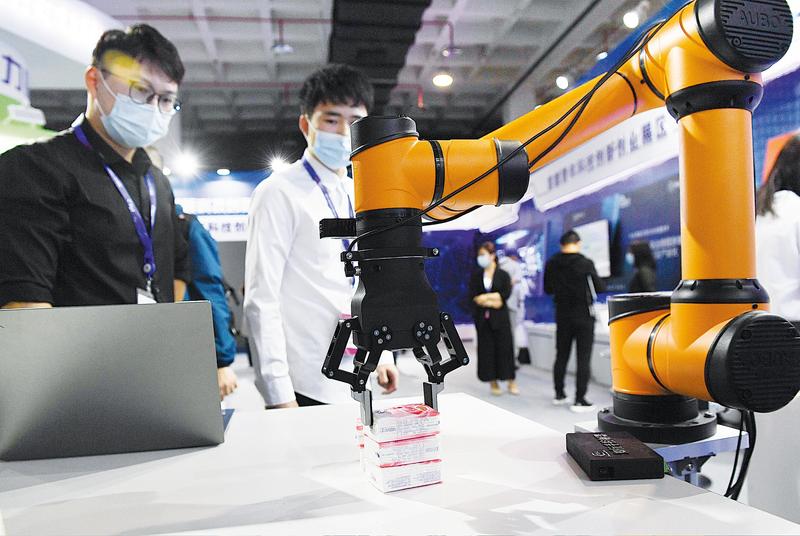 (LI MIN / CHINA DAILY)
(LI MIN / CHINA DAILY)
Increasingly innovative, China is on course to meet its target of becoming a global technology leader within 15 years, according to some of the world’s leading scientific experts.
Their remarks come as President Xi Jinping continues to stress the importance of innovation in upgrading the country’s economy, most recently on a visit to an advanced manufacturer in Changsha, capital of Hunan province, on Sept 18.
Committing US$1.4 trillion to new technology over the next six years as part of its post-COVID-19 recovery plan, the world’s second-largest economy is transitioning from rapid basic process innovator to one making blue-sky breakthroughs in numerous fields.
Eric Thun, Peter Moores associate professor in Chinese Business Studies at Oxford University’s Said Business School, said the country has taken huge strides in terms of its innovative capacity.
“There can be no doubt that China is now a leading innovator. While firms operating in the digital space, such as Tencent and Alibaba, are the most high-profile, there are innovative firms throughout the Chinese economy,” he said.
Peter Williamson, professor of international management at Cambridge University’s Judge Business School, believes there has been a significant change in Chinese innovation.
“The capabilities in rapid innovation and improving industrial processes China has built over the past 20 years have provided an important springboard to become a genuine innovator, competing now in blue-sky research and development,” he said.
“(China) has now reached the leading edge of a range of technologies, including artificial intelligence, biotechnology, quantum computing, renewable energy and satellites.”
John Meewella, group CEO of MiNiSV China-Europe Silicon Valley, an organization based in Nanjing, capital of Jiangsu province, which aims to foster international innovation collaboration, said dramatic developments are taking place in China.
“What the West took hundreds of years to accomplish, China is speeding up at a pace beyond the comprehension of most nations,” he said.
“It is now prepared to take more risks than the United States and the European Union, which have traditionally led innovation in the past, and is on the path to becoming a global leader.”
Xi set what was seen as a bold target for the nation to become a global technology leader by 2035 in his report to the Communist Party of China 19th National Congress in October 2017.
With major national resources being committed to meet this target, many observers believe it is firmly within China’s grasp.
Max von Zedtwitz, a professor at the Copenhagen Business School in Denmark and director of the GLORAD Center for Global R&D and Innovation, which has an office in Shanghai, believes the target will be achieved.
“China has already achieved the status of technology leader in certain confined technology domains. It is absolutely possible, if not to be expected, that China will expand the number of technology domains in which it is a technology leader by 2035,” he said.
Von Zedtwitz, co-author with Georges Haour of Created in China: How China is Becoming a Global Innovator, said it would be difficult for any country to be a leader across all technologies. “No country has that position right now,” he said.
Williamson is also confident China will be a global technology leader, but said this is something that is not always easy to define.
“China, by 2035, will be one of a handful of global leaders in a number of key technologies that will shape the future,” he said.
Duncan Clark, a leading expert on China’s technology sector and author of Alibaba: The House that Jack Ma Built, said the private sector will continue to drive China’s tech efforts.
“China’s challenge is not to have the State direct everything for its 2035 push, but to create the conditions for entrepreneurs — the private sector — to thrive and get there themselves,” he said.
China has renewed its focus on technology in recent weeks, with Shenzhen, the megacity in Guangdong province, marking the 40th anniversary of becoming a special economic zone.
It was among the four original SEZs that played a major role in transforming China’s economy after reform and opening-up began in the late-1970s.
 Visitors check out a smart robot during a high-tech exhibition in Beijing on Sept 17. (JU HUANZONG / XINHUA)
Visitors check out a smart robot during a high-tech exhibition in Beijing on Sept 17. (JU HUANZONG / XINHUA)
Home to tech giants such as Tencent and telecommunications companies Huawei and ZTE, Shenzhen is now often viewed as a rival to Silicon Valley as the world’s major innovation center.
Thun, from Oxford University, who is also a US citizen with firsthand knowledge of Silicon Valley, believes Shenzhen is already holding its own against its Californian counterpart in terms of being a vital technology cluster.
“I see the two as being more complementary, rather than competing, given that Shenzhen’s strength is more on the hardware side and not in software.”
Williamson, from the Judge Business School, believes Shenzhen can even outstrip Silicon Valley because of its different approach to innovation.
He said that compared with their Western counterparts, Chinese digital companies are much more open to innovation driven by the users of their products.
China’s advances in innovation and technology have been a concern for the US government, which announced in August it would cut off supplies of foreign-made semiconductors to Huawei and 38 of its affiliates.
Washington has also made a number of aggressive moves against Chinese technology companies operating in the US, including the WeChat social messaging app owned by Tencent, and TikTok, the video-sharing app owned by ByteDance.
Last weekend, a federal judge temporarily blocked US President Donald Trump’s executive order to stop US citizens using WeChat, and TikTok has now agreed a deal with Oracle and Walmart that could allow it to continue operating in the US.
Thun does not believe such moves by the US will slow Chinese innovation.
“If you take the actions against Huawei, I suspect they will ultimately be self-defeating, because they will highlight exactly where Chinese weaknesses in this sector lie,” he said, adding that in the long term, Huawei will be able to replace input that is being cut off by the US.
Clark, the China technology expert, said one of the major questions being asked in the global technology industry is whether the current trade tensions will spur China’s innovation efforts.
“As we know, necessity is the mother of invention. Is decoupling creating a new necessity, and will it be the mother of a new phase of invention in China?” he asked.
China is sometimes criticized in the West for the State aid allocated to research and development. The country is home to some major scientific and technology institutes as well as a huge nationwide network of science parks through which funding is delivered.
Some observers believe those attacking China often ignore the level of funding the US government plowed into the NASA space program in the 1960s. Meanwhile, one of the major sticking points in talks between the United Kingdom and the European Union to secure a free trade agreement is the UK’s insistence on freedom to deliver government aid to new technology businesses.
Von Zedtwitz, at the Copenhagen Business School, said the question is often whether China’s State aid has “nationalistic intentions”.
“To otherwise invest in national capacity for technology is perfectly fine — many countries have done that, or should be doing it,” he said.
One of China’s main innovation drivers is producing more STEM (science, technology, engineering and mathematics) graduates than any other country.
According to the World Economic Forum, the country produced 4.7 million such graduates in 2016, compared with 568,000 in the US, which for a long period delivered more than any other nation.
Abishur Prakash, a geopolitical futurist at the Center for Innovating the Future, a strategic consultancy based in Toronto, believes remarkable developments are taking place at Chinese universities.
“These universities are no longer limited to the academic domain — they are also powering China’s commercial sector,” he said.
“Global firms are emerging from universities, such as Megvii, one of the world’s largest facial recognition companies, which was built by Tsinghua (University) graduates.”
Clark believes technology should be a global collaborative effort and that the number of China’s STEM graduates should be regarded as a positive step for the world.
He regrets the US administration’s restrictions on Chinese students at US universities, and believes this can only be counterproductive.
“By doing so, the US is imposing substantial costs on both itself and China, because benefits are felt through the exchange of talent, ideas, and also in creating wealth,” Clark said.
None of this is likely to daunt China on its march to becoming a global technology leader, which is vital for transforming its economy.
Derrick S.C. Kon, a senior executive with management consultancy Gao Feng Advisory, said there have already been radical breakthroughs in digital technology, but he expects others to emerge in areas including new energy, autonomous vehicles and railway technology.
“I expect China to be strong in many areas in the future. Chinese companies are very good at addressing the needs of customers as well as being entrepreneurial, forward-looking and pragmatic,” he said.


